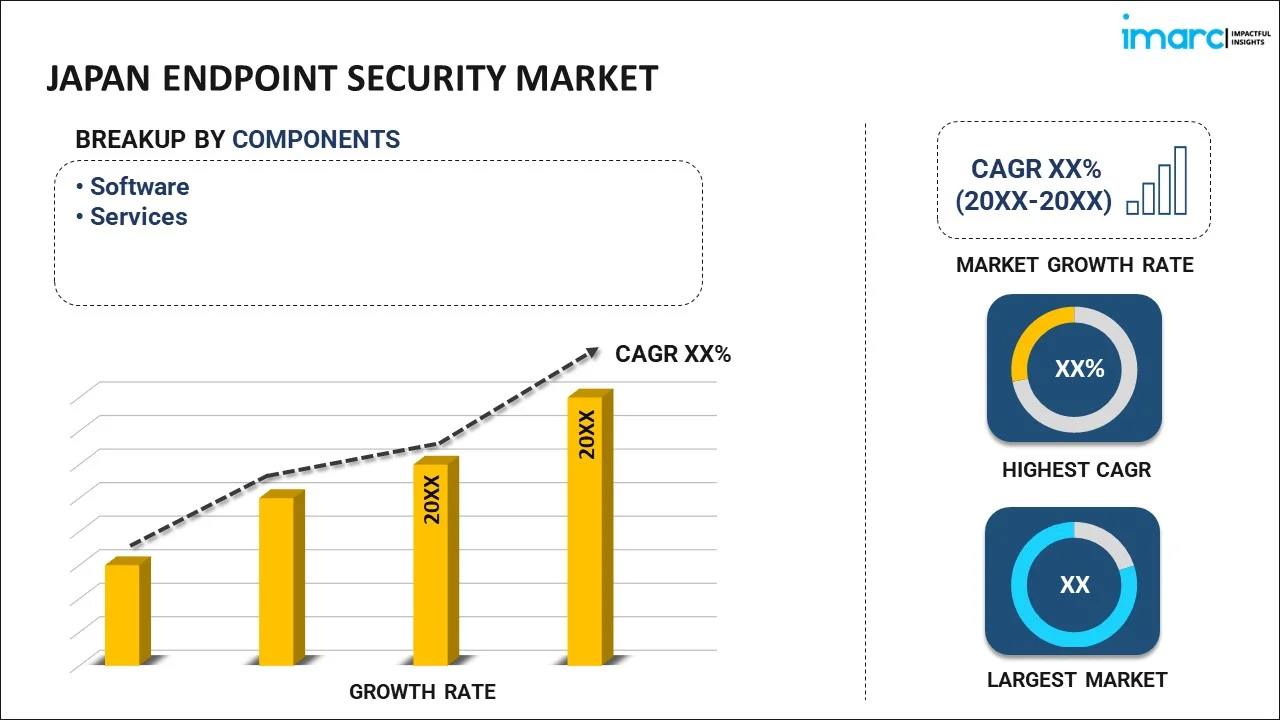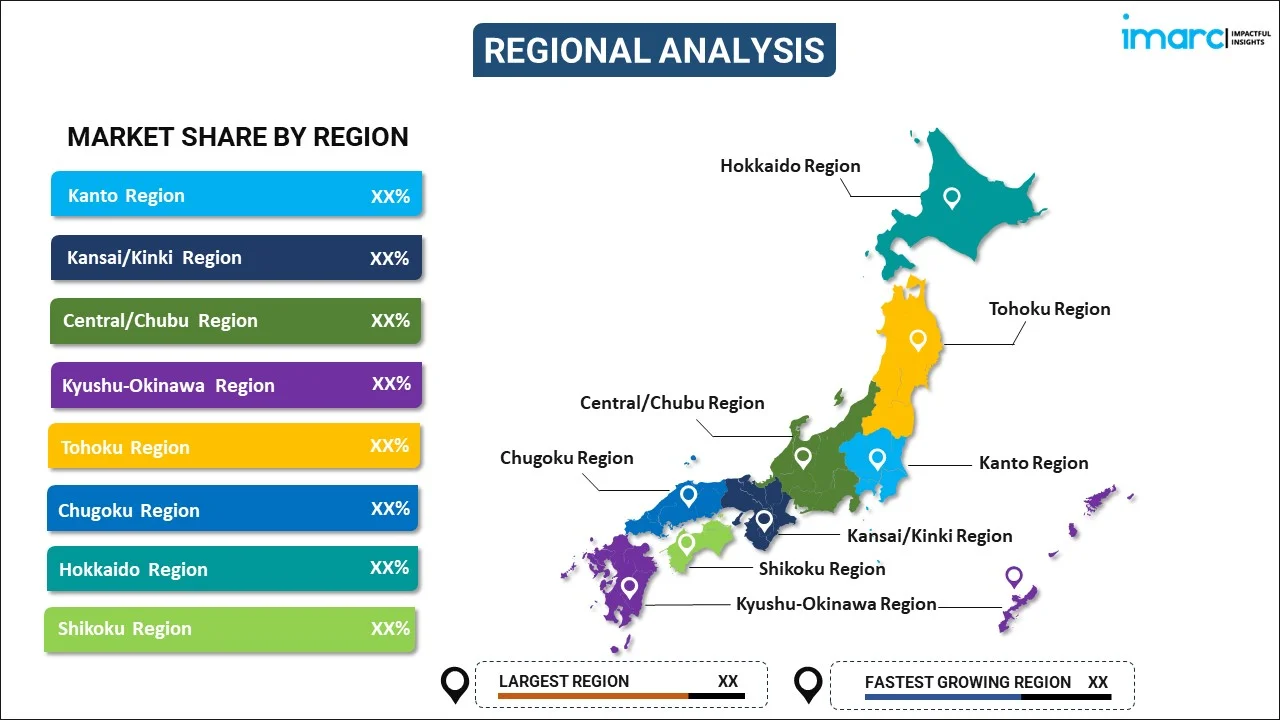
Japan Endpoint Security Market Report by Component (Software, Services), Deployment Mode (On-premises, Cloud-based), Organization Size (Large Enterprises, Small and Medium-sized Enterprises), Vertical (Banking, Financial Services and Insurance (BFSI), IT and Telecommunications, Government and Defense, Healthcare and Life Sciences, Manufacturing, Retail and E-Commerce, and Others), and Region 2025-2033
Market Overview:
Japan endpoint security market size reached USD 1,182.8 Million in 2024. Looking forward, IMARC Group expects the market to reach USD 3,707.8 Million by 2033, exhibiting a growth rate (CAGR) of 13.5% during 2025-2033. The increasing demand for more reliable and scalable data processing and storage facilities and stringent regulatory compliance represent some of the key factors driving the market.
|
Report Attribute
|
Key Statistics
|
|---|---|
|
Base Year
|
2024 |
|
Forecast Years
|
2025-2033
|
|
Historical Years
|
2019-2024
|
| Market Size in 2024 | USD 1,182.8 Million |
| Market Forecast in 2033 | USD 3,707.8 Million |
| Market Growth Rate (2025-2033) | 13.5% |
Endpoint security refers to the protection of data and the operational flow of user devices, including laptops, desktops, and mobile phones, from potential exploitation by malicious threats and cyber assaults. Its functionality involves scrutinizing incoming files within the network and fortifying endpoints via application control and encryption. This security approach offers a unified, centralized solution, streamlining security management, enhancing business durability, and amplifying overall earnings. In the present era, industry participants are introducing solutions that furnish endpoint detection and response (EDR) capabilities, enabling the identification of sophisticated threats like polymorphic attacks, fileless malware, and zero-day attacks.
Japan Endpoint Security Market Trends:
The Japan endpoint security market is responding to the escalating volume and complexity of cybersecurity threats, including hacktivism, organized crime, and both malicious and inadvertent insider attacks, which can result in the compromise of sensitive information, financial instability, and substantial damage to reputation. Consequently, businesses across various industry sectors are deploying endpoint security systems to swiftly identify, analyze, block, and contain the usage of unauthorized or unsafe applications, thereby mitigating the risk of data loss. Furthermore, the growing trend of bring your own device (BYOD) and the increasing adoption of remote work policies in small and medium-sized enterprises (SMEs) are fueling the demand for advanced endpoint security solutions, ensuring rapid detection and response times for remediation. Additionally, market participants are introducing contemporary endpoint security solutions in cloud-based models, reducing the necessity for local storage of threat information databases and simplifying the updating process. Given the scalability of cloud-based products and their seamless integration with the latest IT infrastructure, the application of endpoint security is expected to expand across various sectors, including retail, healthcare, transportation, telecommunications, and banking, financial services, and insurance (BFSI).
Japan Endpoint Security Market Segmentation:
IMARC Group provides an analysis of the key trends in each segment of the market, along with forecasts at the country level for 2025-2033. Our report has categorized the market based on component, deployment mode, organization size, and vertical.
Component Insights:

- Software
- Services
The report has provided a detailed breakup and analysis of the market based on the component. This includes software and services.
Deployment Mode Insights:
- On-premises
- Cloud-based
A detailed breakup and analysis of the market based on the deployment mode have also been provided in the report. This includes on-premises and cloud-based.
Organization Size Insights:
- Large Enterprises
- Small and Medium-sized Enterprises
The report has provided a detailed breakup and analysis of the market based on the organization size. This includes large enterprises and small and medium-sized enterprises.
Vertical Insights:
- Banking, Financial Services and Insurance (BFSI)
- IT and Telecommunications
- Government and Defense
- Healthcare and Life Sciences
- Manufacturing
- Retail and E-Commerce
- Others
A detailed breakup and analysis of the market based on the vertical have also been provided in the report. This includes banking, financial services and insurance (BFSI), IT and telecommunications, government and defense, healthcare and life sciences, manufacturing, retail and e-commerce, and others.
Regional Insights:

- Kanto Region
- Kansai/Kinki Region
- Central/ Chubu Region
- Kyushu-Okinawa Region
- Tohoku Region
- Chugoku Region
- Hokkaido Region
- Shikoku Region
The report has also provided a comprehensive analysis of all the major regional markets, which include Kanto Region, Kansai/Kinki Region, Central/ Chubu Region, Kyushu-Okinawa Region, Tohoku Region, Chugoku Region, Hokkaido Region, and Shikoku Region.
Competitive Landscape:
The market research report has also provided a comprehensive analysis of the competitive landscape. Competitive analysis such as market structure, key player positioning, top winning strategies, competitive dashboard, and company evaluation quadrant has been covered in the report. Also, detailed profiles of all major companies have been provided.
Japan Endpoint Security Market Report Coverage:
| Report Features | Details |
|---|---|
| Base Year of the Analysis | 2024 |
| Historical Period | 2019-2024 |
| Forecast Period | 2025-2033 |
| Units | Million USD |
| Scope of the Report | Exploration of Historical Trends and Market Outlook, Industry Catalysts and Challenges, Segment-Wise Historical and Future Market Assessment:
|
| Components Covered | Software, Services |
| Deployment Modes Covered | On-premises, Cloud-based |
| Organization Sizes Covered | Large Enterprises, Small and Medium-sized Enterprises |
| Verticals Covered | Banking, Financial Services and Insurance (BFSI), IT and Telecommunications, Government and Defense, Healthcare and Life Sciences, Manufacturing, Retail and E-Commerce, Others |
| Regions Covered | Kanto Region, Kansai/Kinki Region, Central/ Chubu Region, Kyushu-Okinawa Region, Tohoku Region, Chugoku Region, Hokkaido Region, Shikoku Region |
| Customization Scope | 10% Free Customization |
| Post-Sale Analyst Support | 10-12 Weeks |
| Delivery Format | PDF and Excel through Email (We can also provide the editable version of the report in PPT/Word format on special request) |
Key Questions Answered in This Report:
- How has the Japan endpoint security market performed so far and how will it perform in the coming years?
- What has been the impact of COVID-19 on the Japan endpoint security market?
- What is the breakup of the Japan endpoint security market on the basis of component?
- What is the breakup of the Japan endpoint security market on the basis of deployment mode?
- What is the breakup of the Japan endpoint security market on the basis of organization size?
- What is the breakup of the Japan endpoint security market on the basis of vertical?
- What are the various stages in the value chain of the Japan endpoint security market?
- What are the key driving factors and challenges in the Japan endpoint security?
- What is the structure of the Japan endpoint security market and who are the key players?
- What is the degree of competition in the Japan endpoint security market?
Key Benefits for Stakeholders:
- IMARC’s industry report offers a comprehensive quantitative analysis of various market segments, historical and current market trends, market forecasts, and dynamics of the Japan endpoint security market from 2019-2033.
- The research report provides the latest information on the market drivers, challenges, and opportunities in the Japan endpoint security market.
- Porter's five forces analysis assist stakeholders in assessing the impact of new entrants, competitive rivalry, supplier power, buyer power, and the threat of substitution. It helps stakeholders to analyze the level of competition within the Japan endpoint security industry and its attractiveness.
- Competitive landscape allows stakeholders to understand their competitive environment and provides an insight into the current positions of key players in the market.
Need more help?
- Speak to our experienced analysts for insights on the current market scenarios.
- Include additional segments and countries to customize the report as per your requirement.
- Gain an unparalleled competitive advantage in your domain by understanding how to utilize the report and positively impacting your operations and revenue.
- For further assistance, please connect with our analysts.
 Inquire Before Buying
Inquire Before Buying
 Speak to an Analyst
Speak to an Analyst
 Request Brochure
Request Brochure
 Request Customization
Request Customization




.webp)




.webp)












